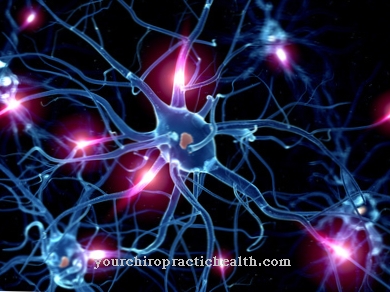Under the Nasal cycle medicine understands an ultradian rhythm that makes the nasal mucous membranes swell and swell alternately. This alternation of work and rest phases serves to regenerate the mucous membranes. An exaggerated nasal cycle is also known as specific or non-specific nasal hyperreactivity.
What is the nasal cycle?

The nasal cycle is the alternating swelling and swelling of the mucous membrane areas in the two turbinates. This process takes place permanently and independently of external stimuli. A cycle lasts between around 30 minutes and 14 hours. An average of about 2.5 hours is set for a nasal cycle.
However, the inter-individual differences are serious. Because its periods are less than 24 hours, the nasal cycle is assigned to the ulradian rhythms. When the mucous membranes are swollen, the working phase is also referred to within the ultradian nasal cycle. The swollen state, on the other hand, is called the resting phase.
The nasal cycle continues both during the day and at night. The day and night cycle, however, differ in the amount of air. The relative air flow between the rest and work phase is greater during the night than during the day. The Breslau doctor Kayser first described the nasal cycle at the end of the 19th century. Today the phenomenon is mainly associated with regenerative effects.
Function & task
The nasal cycle is controlled by the brain region of the sympathetic nervous system. This area of the brain performs important tasks in the autonomic nervous system. The sympathetic and the parasympathetic complement each other and regulate organ activity with the utmost precision.
The effect of the sympathetic nervous system is described as ergotropic, since the regulatory center increases the ability to act externally. The nerve stimuli and body functions controlled by this are independent of the arbitrary control and thus take place permanently and unconsciously. The hypothalamus is the supreme regulatory center for all vegetative processes, for example for the circulatory system or body temperature. This part of the diencephalon takes over the neuronal coordination in the nasal cycle.
During the nasal cycle, the mucous membrane of one nasal concha is always swollen, while that of the other side is in the working phase. In this working phase, a much higher air flow penetrates the nose than during the turbulence-free resting phase. The swollen state in the resting phase minimizes the air that reaches the mucous membranes. Therefore, the mucous membrane releases significantly less moisture to the nose during the resting phase.
Since air can penetrate the nose unhindered during the work phase due to the swollen state, the need for humidification is all the greater for the mucous membrane in this phase.
The resting phase therefore serves to relax and regenerate the nasal mucous membranes. In this phase of regeneration, the mucous membrane not only saves moisture, but also energy. The body's own regeneration processes reach their peak in the night phase.
The nasal mucous membranes primarily play a role as protective devices against inhaled foreign bodies and pathogens. Their cilia beat up to 900 times per minute and thus transport foreign substances away. The regeneration processes ensure that the mucous membranes remain functional. Especially after colds or infections, the ability to regenerate is important for restoring the protective functions. Although the mucous membranes could recover without the nasal cycle, the regeneration would probably be less effective if the cycle did not exist.
You can find your medication here
➔ Medication for shortness of breath and lung problemsIllnesses & ailments
One of the most well-known ailments related to the nasal cycle is nasal hyperreactivity. In this phenomenon, the natural nasal cycle is disturbed by contact with external stimuli. The mucous membrane of the nose naturally reacts to certain stimuli with nasal obstruction, sneezing or similar phenomena. Nasal breathing obstruction or nasal obstruction as a reaction to chemical, physical or pharmacological stimuli is called nasal hyperreactivity.
In this context, medicine differentiates between specific and non-specific hyperreactivity. With specific hyperreactivity, the patient reacts excessively to allergens. If, on the other hand, he reacts with a nasal obstruction to a change in his own body position, to exertion or to environmental stimuli such as smoke, vapors or cold air, we are talking about unspecific hyperreactivity.
Both inflammation and disorders of nerve control play a role in the context of hyperreactivity. The production and release of the body's own substances such as neurotransmitters changes and the receiving receptors of the vessels and nerves or glands overreact. An allergic rhinitis develops. Around 15 percent of the population suffer from such rhinitis.
The nasal cycle has also been observed in the field of sleep medicine. Particularly for patients with sleep apnea syndrome, abnormalities in the nasal cycle were documented. Those affected by sleep apnea syndrome suffer from small respiratory arrests during the sleep phase. According to research into sleep medicine, there is an indisputable connection between your nasal cycle and your body position during sleep. In patients, for example, the turbinate swells on the side on which the patient lies asleep. The increased tone of the sympathetic nervous system is assumed to be the cause of this observation in sufferers of sleep apnea syndrome.
The nasal cycle also plays a role in colds and other infections. Colds and flu can therefore temporarily imbalance the natural rhythm.



























